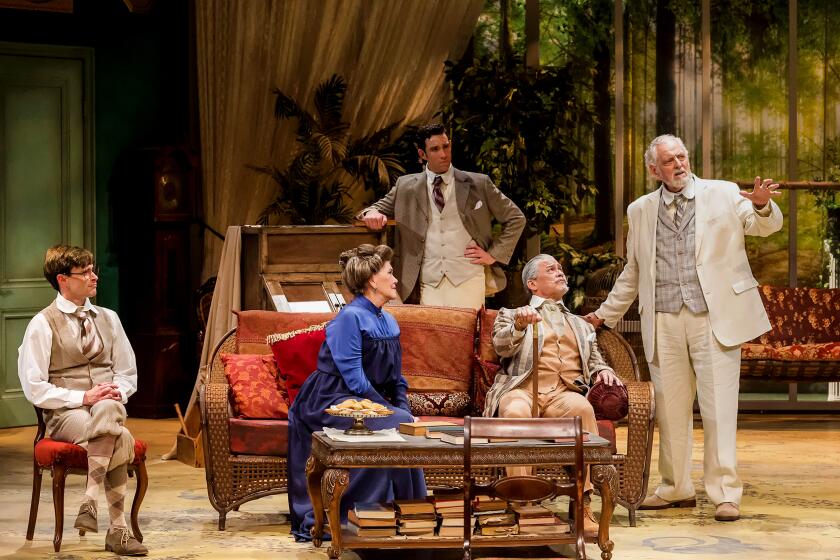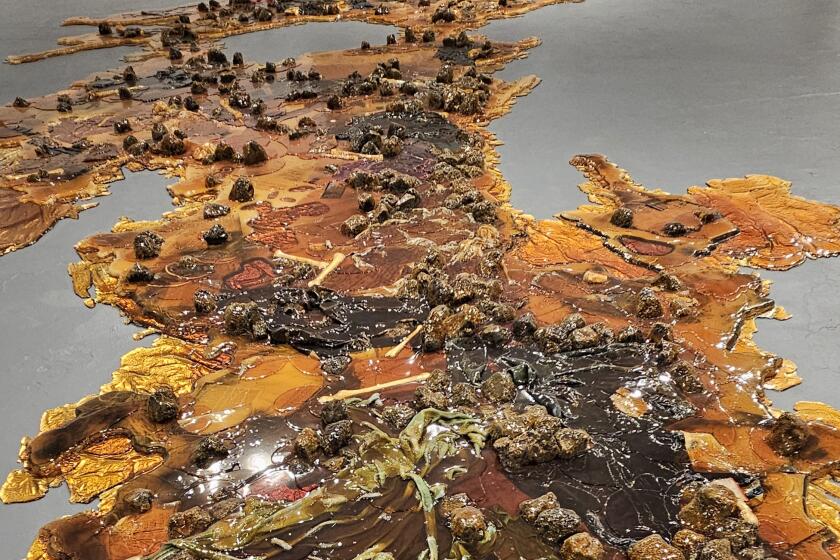Long-Suppressed Works Go on View as Sotheby’s Readies Unprecedented Auction
Avant-Garde and contemporary artworks that once would have been banned from public view have gained the blessing of the Soviet government and the attention of a worldwide audience. In a glowing example of glasnost , 101 contemporary Soviet paintings and mixed-media constructions, along with 18 drawings, paintings and photographs from the early 20th-Century Russian Avant-Garde movement have gone on exhibition here just prior to an unprecedented auction.
The art that Sotheby’s of London will offer for sale Thursday evening at the Sovincentr constitutes a parade of themes and styles formerly forbidden from public consumption in the Soviet Union. Formal abstractions and emotional portrayals of human dilemmas mingle with witty commentaries on military surveillance and the abuse of power, abstruse conceptual projects, fantasies of delight and horror, works inspired by Jewish lore and examples of personal poetry.
That these works are shown at all marks a stunning change in policy and raises the stature of independent artists. The upcoming auction has brought new respect and the prospect of wealth to artists whose country has long controlled free expression through unions that police exhibitions and dole out jobs to cooperative members.
Sotheby’s sale--a joint venture with the Soviet Ministry of Culture--is expected to attract more than 1,000 bidders and spectators, including artists who seem baffled by rituals of the Western marketplace and stunned to be in the limelight.
“You must understand that until three years ago, we had few contacts with the Western public,” said 74-year-old artist Ilya Tabenkin. “The artists who had a chance to travel abroad and exhibit their work were not our best. We have had a very low standard for a very long time, with artists oriented toward photographic copies of nature, idealistic realism and the Russian masters, but this is quite different.”
His oils in the auction transform isolated still-life objects into lonely human images and “express the inner world of the artist,” according to the elfin painter.
“This exhibition does not represent all the trends in Soviet painting, but there are some very interesting things here. I think it is a very positive event,” said Tabenkin.
“I like it,” echoed his 36-year-old son, Lev Tabenkin, who also has paintings in the auction. Asked what the sale might mean to him and his career, the younger Tabenkin said, “I will have to answer that after the auction. Now I can only say that this is a wonderful event in our cultural life. It is important for artists, but this is my first auction and I am not familiar with how it works.”
Having poured enormous effort, diplomacy and an undisclosed sum of money intoorganizing the affair, publishing a bilingual (Russian and English) catalogue and launching a preview tour of the art in New York, London, Paris, Cologne and Zurich, Sotheby’s officials are also taking a wait-and-see attitude.
“I hope this can develop into a regular event, but I will be able to tell you more on July 8,” said Simon de Pury, managing director of Sotheby’s Europe. “We do not see the sale as a big profit-making event, but we don’t expect to lose money on it. This is not just a gimmick.”
By Western standards, the auction is a small one, expected to total about $1 million. Individual works are expected to bring from about $3,000 to $200,000, with most of the contemporary pieces estimated at under $10,000.
According to De Pury, the artists (or their descendants who consigned the work) will get 60% of the hammer price, 10% of it in hard currency and the remainder in gold rubles (worth three times the value of standard rubles). The Soviet Ministry of Culture will take 32%, giving 2% to a recently established foundation that promotes the arts. Sotheby’s will reap the final 8%, plus the standard 10% buyer’s commission of the hammer price.
“The artists’ percentage may sound low to us, but compared to what they are accustomed to, it’s significant,” De Pury said. (When the sale was first announced, a Soviet official was quoted as saying the artists would get 80% of the hammer price, but that proved erroneous.)
The exhibition fills two adjacent “congress halls” at the immense Sovincentr, an international trade and hotel complex that flaunts such incongruities as fake trees, real fish and a bronze clock tower topped by a mechanical crowing rooster--all situated in a 10-floor atrium that reminds Americans of a Hyatt hotel.
For the auction, the two halls (separated by a movable wall) will be merged into one vast sale room where aficionados will find an approximation of a Sotheby’s New York auction. Except for the most unwieldy pieces, each lot will be brought to the front of the room, where De Pury will serve as auctioneer. He will take bids from the floor, by telephone and advance orders. According to De Pury, there’s still time for absentees to participate by calling Sotheby’s New York (212) 606-7000 or sending a message to Moscow by Telex (411446A EKSPSU) or Telefax: 253-92-69.
All purchases are expected to be by foreigners because the auction will be conducted in pounds sterling. Most Soviets have little access to foreign currency or the Sovincentr, though De Pury says some Soviets will attend the unusual affair.
A steady stream of Russian-speaking visitors has been flowing into the exhibition this week and the Eastern Bloc press has already indicated a strong interest in the event. A Soviet television crew turned up to film the exhibition and more than 100 journalists from the Eastern Bloc had registered for credentials by the end of last week.
“This is very exciting for us, but it’s sad that there will be no (bidding) competition from the Russians,” said Vladimir Galin, a reporter for the Moscow-based weekly publication New Times. “It’s important for us to see this art now, because it will go away and we’ll never see it again.”
News of the auction has appeared in Moscow newspapers and magazines. Artists say that interest in the event has spread far beyond the art community.
“The public is very active now. It reacts very energetically to all manifestations of our times,” said Lev Tabenkin. “This is widely seen as an opportunity to establish broader contact with Western art.”
More to Read
The biggest entertainment stories
Get our big stories about Hollywood, film, television, music, arts, culture and more right in your inbox as soon as they publish.
You may occasionally receive promotional content from the Los Angeles Times.






